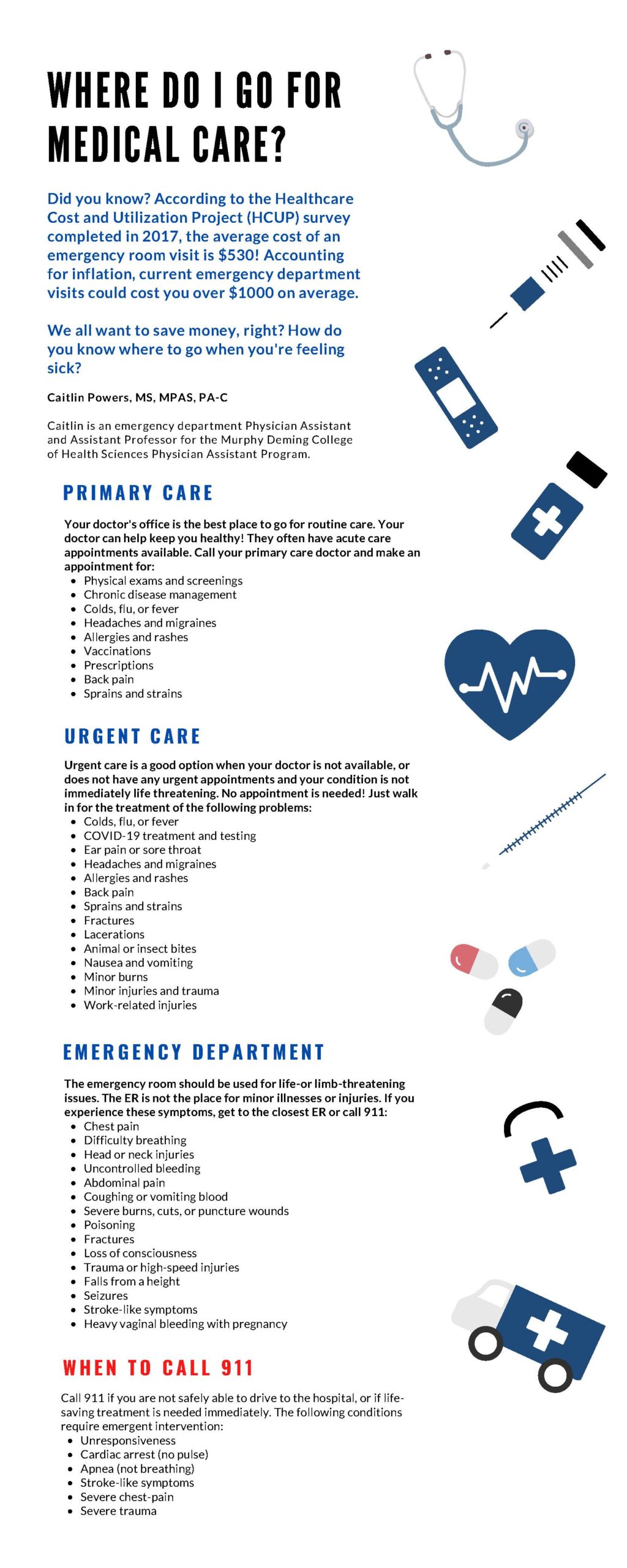By: Caitlin Powers, MS, MPAS, PA-C
Assistant Professor, Physician Assistant Program
Did you know? According to the Healthcare Cost and Utilization Project (HCUP) survey completed in 2017, the average cost of an emergency room visit is $530. Accounting for inflation, current emergency department visits could cost you over $1,000 on average.
We all want to save money, right? How do you know where to go when you’re feeling sick?

PRIMARY CARE
Your doctor’s office is the best place to go for routine care. Your doctor can help keep you healthy! They often have acute care appointments available. Call your primary care doctor and make an appointment for:
- Physical exams and screenings
- Chronic disease management
- Colds, flu, or fever
- Headaches and migraines
- Allergies and rashes
- Vaccinations
- Prescriptions
- Back pain
- Sprains and strains
URGENT CARE
Urgent care is a good option when your doctor is not available, or does not have any urgent appointments and your condition is not immediately life threatening. No appointment is needed. Just walk in for the treatment of the following problems:
- Colds, flu, or fever
- COVID-19 treatment and testing
- Ear pain or sore throat
- Headaches and migraines
- Allergies and rashes
- Back pain
- Sprains and strains
- Fractures
- Lacerations
- Animal or insect bites
- Nausea and vomiting
- Minor burns
- Minor injuries and trauma
- Work-related injuries
EMERGENCY DEPARTMENT
The emergency room should be used for life-or limb-threatening issues. The ER is not the place for minor illnesses or injuries. If you experience these symptoms, get to the closest ER or call 911:
- Chest pain
- Difficulty breathing
- Head or neck injuries
- Uncontrolled bleeding
- Abdominal pain
- Coughing or vomiting blood
- Severe burns, cuts, or puncture wounds
- Poisoning
- Fractures
- Loss of consciousness
- Trauma or high-speed injuries
- Falls from a height
- Seizures
- Stroke-like symptoms
- Heavy vaginal bleeding with pregnancy
WHEN TO CALL 911
Call 911 if you are not safely able to drive to the hospital, or if life-saving treatment is needed immediately. The following conditions require emergent intervention:
- Unresponsiveness
- Cardiac arrest (no pulse)
- Apnea (not breathing)
- Stroke-like symptoms
- Severe chest-pain
- Severe trauma
About the Author

Caitlin Powers, MS, MPAS, PA-C, is an emergency department physician assistant and assistant professor for the Murphy Deming College of Health Sciences Physician Assistant Program.
